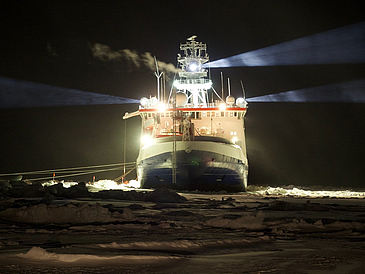During the MOSAiC expedition, hundreds of environmental parameters were recorded with unprecedented accuracy and frequency over a full annual cycle in the Central Arctic Ocean. Researchers have now published three overview articles on the atmosphere, snow, and sea ice, as well as ocean programs in the Elementa journal, highlighting the importance of examining all components of the climate system together. These results present the first complete picture of the climate processes in the central Arctic, which is warming more than two times as fast as the rest of the planet - processes which affect weather and climate worldwide.
Diminishing sea ice is a symbol of ongoing global warming: in the Arctic, its extent has almost halved in summer since satellite records began in the 1980s. Less well studied but equally relevant are the thickness and other properties of the ice. The question of what this means for the future Arctic and how these changes will affect the global climate were the impetus for the historic MOSAiC expedition with the German research icebreaker Polarstern from September 2019 to October 2020.
Most Complete Picture of Climate Processes
Researchers from institutes in 20 countries spent around ten years preparing the expedition, which cost around 150 million euros in total. The majority of that sum was provided by the Federal Ministry of Education and Research. With the results that are coming out now the researchers are building the most complete observation-based picture of climate processes in the Arctic.
To study the relevant processes for a full year required a special concept, in part because the Central Arctic Ocean is still ice-covered in winter and therefore difficult to access. During the expedition, the icebreaker froze to a large ice floe and drifted with the natural transpolar drift across the Arctic Ocean.
Four University of Bremen Research on Board
The University of Bremen was involved in the expedition in the areas of sea ice, remote sensing, and oceanography and with four persons on board and contributed to all three overview articles.
Satellite data forms the backbone for our understanding of the sea ice changes in the Arctic. Due to the harsh environmental conditions and the low population density in the Arctic, we have to rely on satellite observations, especially in winter. Beyond the sea ice area, we nowadays can obtain information about ice thickness, ice types, melt pond coverage, or snow on the sea ice with the help of satellites. “Many of these methods are developed at the Institute of Environmental Physics at the University of Bremen,” states Dr. Gunnar Spreen, researcher and head of the Sea Ice Remote Sensing research group at the University of Bremen.
Remote Sensing Instruments Set Up on MOSAiC Ice Floe
To also develop new methods for upcoming satellite missions of ESA, NASA, or the EU Copernicus, remote sensing instruments were deployed on the MOSAiC ice floe. The University of Bremen coordinated and led these activities. “We put the so far largest collection of 14 remote-sensing instruments on the ice to observe the same snow and sea ice spot at the same time. There are similar counterparts on satellites in space. Together with detailed snow and ice observations, these measurements pave the way for new sea ice observations from upcoming satellite missions. This will also allow for better uncertainty assessments of existing satellite time series and thus improve climate models,” explains Spreen.
Initial results already show that a combination of radar observations at different frequencies can provide snow depth on sea ice information. But also, that current satellite methods can fail to produce reliable data when warm air intrusions or rain on snow events change the microwave properties of the surface. Gunnar Spreen: “Such algorithm shortcomings can now be improved with the help of the MOSAiC measurements.”
New Insights into Exchange Processes Possible
The Oceanography research group, also located at the Institute of Environmental Physics, coordinated the sampling of anthropogenic trace substances (CFCs) and noble gas isotopes (helium and neon) during MOSAiC and performed the measurements in the in-house laboratories after the expedition. This data set promises to provide new insights into the exchanges between the atmosphere, upper ocean, and underlying water layers during changing ice conditions.
"Collecting water samples in the Arctic winter, especially in the ice camp outside Polarstern, presented significant logistical and personal challenges for the researchers on board. Through their efforts, we are now able to better understand vertical and horizontal exchange processes under the ice based on trace substances," says Dr. Maren Walter from the Oceanography research group.
The three overview articles serve as references for a vast array of future scientific work. "The physical observations are the basis for interpreting biogeochemical cycles and ecosystem processes, and for supporting coupled models that we use to learn even more about climate feedbacks and the global repercussions of Arctic change. These changes can affect weather and climate worldwide," says Prof. Markus Rex, head of MOSAiC and atmospheric scientist at AWI.
Background Information on MOSAiC
During the Multidisciplinary drifting Observatory for the Study of Arctic Climate (MOSAiC) expedition, experts from 20 nations explored the Arctic for an entire year. From autumn 2019 to autumn 2020, the German research icebreaker Polarstern drifted frozen in the ice through the Arctic Ocean. MOSAiC was coordinated by the Alfred Wegener Institute, Helmholtz Centre for Polar and Marine Research (AWI). In order to make this unique project a success and to obtain the most valuable data possible, more than 80 institutes pooled their resources in a research consortium. The total cost of the expedition was about 150 million euros, mostly funded by the German Federal Ministry of Education and Research.
All articles can be found in the Elementa special feature: https://online.ucpress.edu/elementa/collection/269/Special-Feature-The-Multidisciplinary-Drifting
Further Information:
www.uni-bremen.de/en/
Contact:
Dr. Gunnar Spreen
Institute of Environmental Physics (IUP)
Phone: + 49 421 218-62158
Email: gunnar.spreenprotect me ?!uni-bremenprotect me ?!.de

